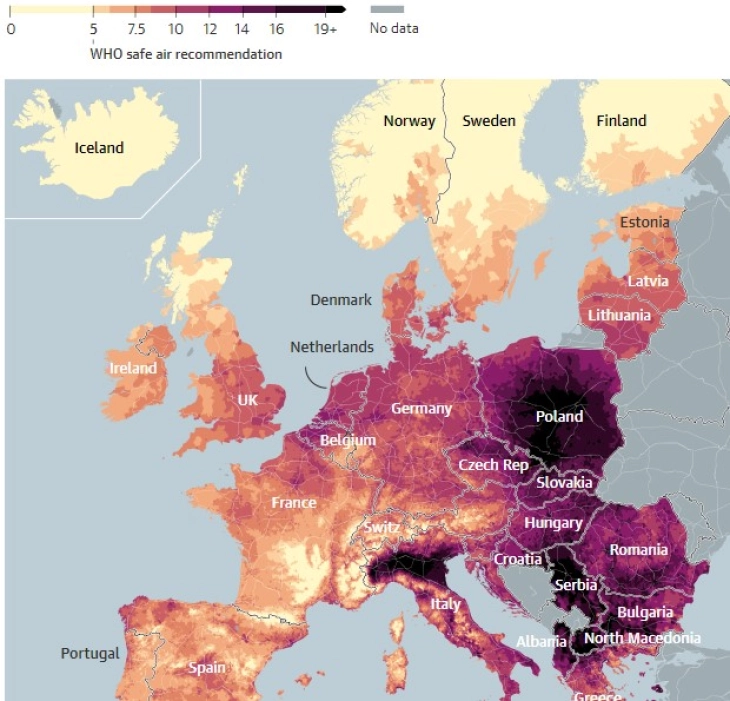The Guardian: Almost everyone in Europe is breathing toxic air, worst hit country is North Macedonia
- Europe is facing a “severe public health crisis”, with almost everyone across the continent living in areas with dangerous levels of air pollution, an investigation by the Guardian has found.

London, 20 September 2023 (The Guardian/MIA) - Europe is facing a “severe public health crisis”, with almost everyone across the continent living in areas with dangerous levels of air pollution, an investigation by the Guardian has found.
Analysis of data gathered using cutting-edge methodology – including detailed satellite images and measurements from more than 1,400 ground monitoring stations – reveals a dire picture of dirty air, with 98% of people living in areas with highly damaging fine particulate pollution that exceed World Health Organization guidelines. Almost two-thirds live in areas where air quality is more than double the WHO’s guidelines.
The worst hit country in Europe is North Macedonia. Almost two-thirds of people across the country live in areas with more than four times the WHO guidelines for PM2.5, while four areas were found to have air pollution almost six times the figure, including in its capital, Skopje.
Eastern Europe is significantly worse than western Europe, apart from Italy, where more than a third of those living in the Po valley and surrounding areas in the north of the country breath air that is four times the WHO figure for the most dangerous airborne particulates.
The Guardian worked with pollution experts to produce an interactive map revealing the worst-hit areas on the continent. The measurements refer to PM2.5 – tiny airborne particles mostly produced from the burning of fossil fuels, some of which can pass through the lungs and into the blood stream, affecting almost every organ in the body.
The current WHO guidelines state that annual average concentrations of PM2.5 should not exceed 5 micrograms a cubic metre (µg/m3). The new analysis found only 2% of the population of Europe live in areas within this limit. Experts say PM2.5 pollution causes about 400,000 deaths a year across the continent.
“This is a severe public health crisis,” said Roel Vermeulen, a professor of environmental epidemiology at Utrecht University who led the team of researchers across the continent that compiled the data. “What we see quite clearly is that nearly everyone in Europe is breathing unhealthy air.”
The data also reveals: Almost all residents in seven countries in eastern Europe – Serbia, Romania, Albania, North Macedonia, Poland, Slovakia and Hungary – have double the WHO guidance.
More than half the population of North Macedonia and Serbia live with four times the WHO figure.
In Germany, three-quarters of the population lives with more than twice the WHO guidance. In Spain that figure is 49%, and in France it is 37%.
In the UK, three-quarters of the population live in areas where exposure is between one and two times the WHO guidance, with almost a quarter over it.
Close to 30 million Europeans are living in areas with small particle concentrations that are at least four times the WHO guidelines.
In Sweden, by contrast, there is no area where PM2.5 reaches more than twice the WHO figure, and some areas in northern Scotland are among the few across Europe that fall below it.
Traffic, industry, domestic heating and agriculture are the main sources of PM2.5 and the impact is often felt disproportionately by the poorest communities.
Air pollution has become a key issue in Europe, with the EU coming under pressure to do more to tackle the growing public health crisis. Last week, the European parliament voted to adopt the WHO guidelines on PM2.5 by 2035. The law, which must still be finalised in negotiations with the council, would set a legally binding limit for annual PM2.5 concentrations of 5µg/m3, down from 25µg/m3 today.
But experts say urgent action needs taking now. They point to a growing body of evidence that shows air pollution affects almost every organ in the body and is linked to a huge range of health problems from heart and lung disease to cancer and diabetes, depression and mental illness to cognitive impairment and low birth weight.
One recent study found air pollution was responsible for 1 million stillbirths a year, another that young people living in cities already have billions of toxic air pollution particles in their hearts.
Dr Hanna Boogaard, an expert on air pollution in Europe at the US Health Effects Institute, said the new analysis was crucial to help inform the debate about air pollution and its effects in the continent, which she said resulted in hundreds of thousands of deaths each year.
“These deaths are preventable and the estimate does not include millions of cases of non-fatal diseases, years lived with disability, attributable hospitalisations, or health effects from other pollutants.”
She said the move to toughen up the EU’s limit provided “a unique opportunity to be bold … and maximise public health benefits for Europe and beyond.”
Some towns and cities across Europe, including London and Milan, are making strides to tackle air pollution, from the introduction of ultra-low emissions zones to traffic reduction schemes and walking and cycling initiatives. But experts say politicians must act with more urgency in light of the growing evidence of harm.
Research has also shown that within countries, poorer communities are more likely to live in areas with the worst air pollution. Barbara Hoffmann, professor of environmental epidemiology at the University of Düsseldorf, said air pollution was an issue of “environmental injustice”.
“The countries that are hit most are also the countries with the lowest mean income, with a few notable exceptions – this illustrates the degree of environmental injustice we are experiencing in the EU. Cleaning up the air specifically in eastern Europe is urgently needed to provide equal opportunities for a healthy life across Europe.”
The data was compiled by academics at Utrecht University in the Netherlands and the Swiss Tropical and Public Health Institute as part of the EU-funded Expanse project. They used a combination of sources, from high-resolution satellite data to pollution monitoring stations and information about land use, to model annual average PM2.5 levels across Europe in 2019.
They say pollution levels will not be significantly different today, but added there may be areas where stringent anti-pollution measures have been implemented that have seen some improvement. The overall result is one of the most accurate and comprehensive pictures of air pollution across the continent to date.
Vermeulen said: “This is the best data that there is available at the moment … Now we need politicians to be bold and ambitious and take the necessary urgent steps to tackle this crisis.”
Photo: The Guardian







